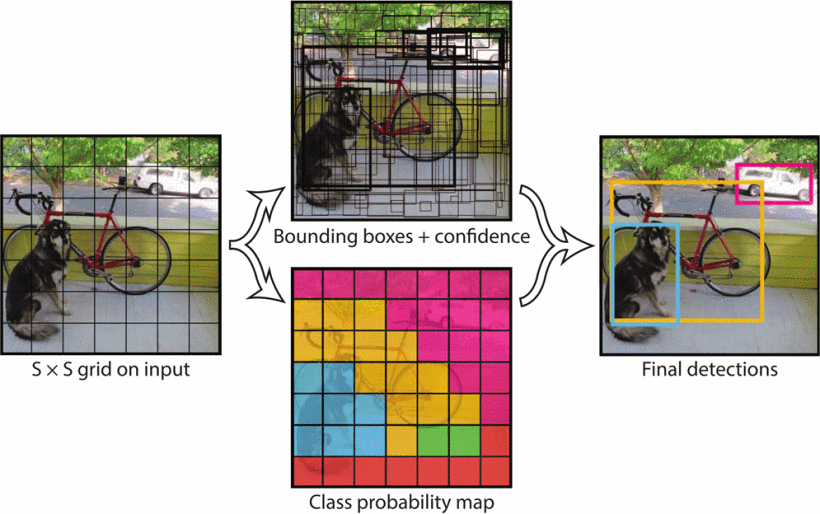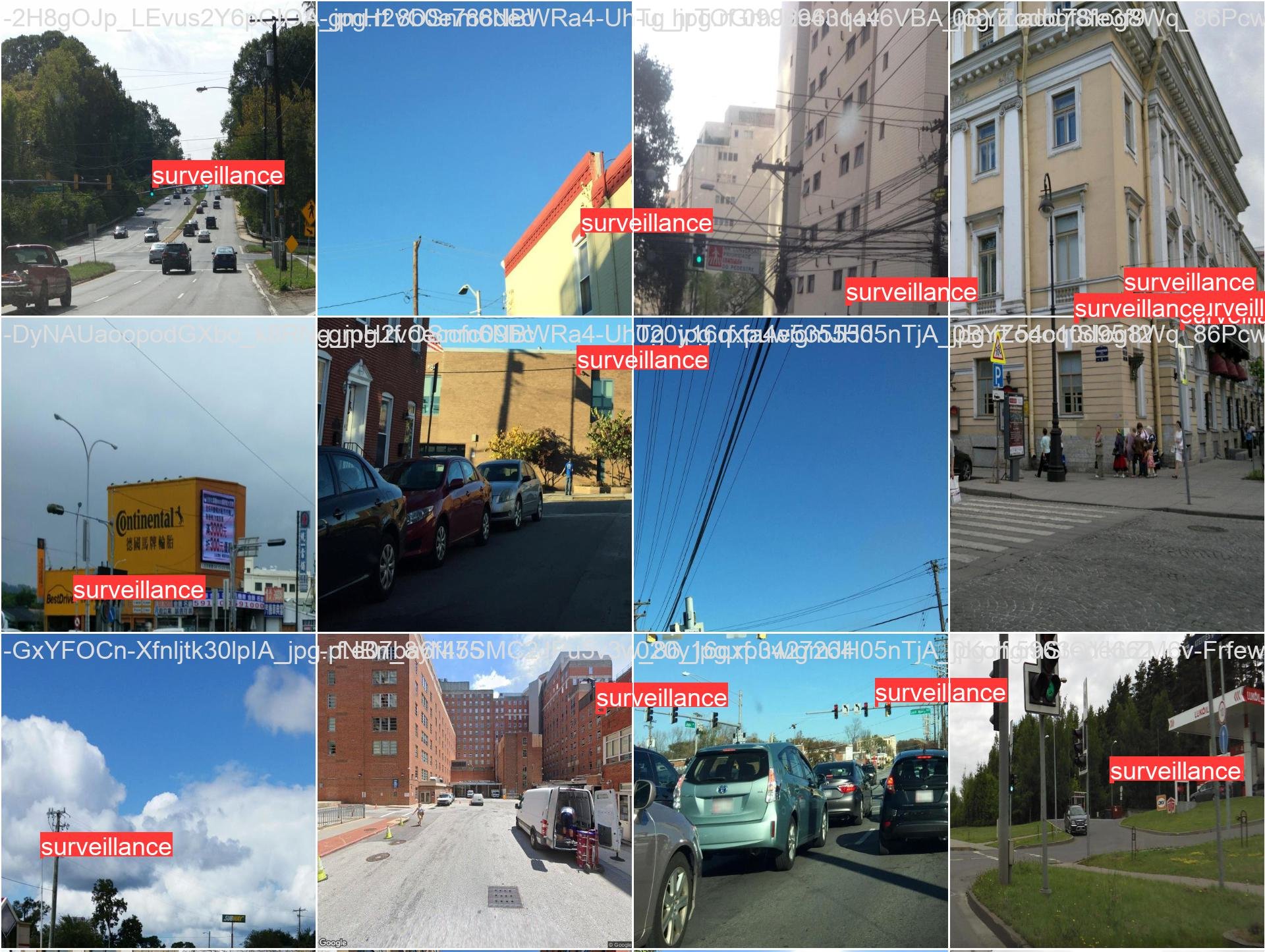Camille Seaberry, capstone for MPS in Data Science, UMBC Fall 2023
Project code: https://github.com/DATA-606-2023-FALL-MONDAY/seaberry_camille
- Police surveillance cameras in Baltimore form one of many layers of state surveillance imposed upon residents.
- Little documentation, control, or oversight of surveillance landscape
- What role do tech vendors play in surveillance? How can open source tech be used for accountability?
- Identify cameras in images (object detection)
- Categorize camera types once detected (classification)
- Improve upon / expand on models I built before—DONE!
- Map locations of cameras for spatial analysis—NOT DONE
| Google Street View | Objects365 | Mapillary Vistas | |
|---|---|---|---|
| Size (train, val, test) | 473 / 119 / 79 | 393 / 107 / 54 | 3,202 / 929 / 484 |
| Setting | Street | Outdoors & indoors | Street |
| Used for | Detection & classification | Detection | Detection |
| Release | Maybe a TOS violation? | Released for research | Released for research |
| Source | Sheng, Yao, and Goel (2021) | Shao et al. (2019) | Neuhold et al. (2017) |
| Ultralytics YOLOv8 | Models with built-in modules for training, tuning, & validation |
| Pytorch | Underlies Ultralytics models |
| Roboflow | Dataset creation & management |
| Weights & Biases | Experiment tracking |
| Paperspace | Virtual machine (8 CPUs, 16GB GPU) |
| YOLO | RT-DETR |
|---|---|
| Latest generation YOLO model | Transformer-based model from Baidu |
| Detection & classification (& others) | Detection only |
| Smaller architecture (medium has 26M params) | Larger architecture (large has 33M params) |
| Trains very quickly & can train small models on laptop | Trains slowly & needs more GPU RAM |
| Doesn’t perform as well | Performs better |
| Well-documented & integrated | New, not fully integrated to ecosystem (e.g. no tune method) |
- Ultralytics released YOLOv8 this year (Jocher, Chaurasia, and Qiu (2023))
- Avoids anchor box calculations and comparisons of other detection models
- Freezing all but last few layers—increased speed, maybe increased accuracy
- Tiling images—better detection of small objects
- No RT-DETR classifier, so just trying different sizes of YOLO
After lots of trial & error, best bets for detection:
- YOLO trained on full-sized images
- YOLO trained on tiled images
- RT-DETR trained on full-sized images with freezing
YOLO works well on tiled images, but it will need to transfer to full-sized images to be useful
Validation labels; validation predictions
- Clearly needs more tuning—these metrics are worse than untuned models!
- Pick a model & tune extensively & methodically—probably YOLO tiled
- However, that model runs the risk of not transferring well
Screenshot of an earlier demo
Working interactive demo: https://camilleseab-surveillance.hf.space
- Many moving parts to work together
- Some components are very new & incomplete
- Hard to find lots of high-quality data
- Google Street View images aren’t permanent
- Formatting images & annotations to be compatible
- Reliable, sustained compute power
- A lot to learn!
- Need a better tuning methodology—switch to W&B
- Longer training—common benchmarks use 300 epochs
- Add slicing to inference step (SAHI, Akyon, Onur Altinuc, and Temizel (2022))
- Label more images for a larger dataset
- Can use AI labelling assistants
- Use the classification model to add classes back to detection images
- Infer on Mapillary images with location data for spatial analysis
- Mapillary already has so many objects annotated, might only need to do this to fill in gaps
- This is a potentially useful start but needs more work still
- Surveillance studies, movements for police accountability seem to be tech-averse (with good reason), but there is a role for the technologies deployed against communities to be used by them as well
- Inherently reactionary to be chasing surveillance state after its infrastructure is built
Akyon, Fatih Cagatay, Sinan Onur Altinuc, and Alptekin Temizel. 2022. “Slicing Aided Hyper Inference and Fine-Tuning for Small Object Detection.” In 2022 IEEE International Conference on Image Processing (ICIP), 966–70. https://doi.org/10.1109/ICIP46576.2022.9897990.
Browne, Simone. 2015. Dark Matters: On the Surveillance of Blackness. Durham, NC: Duke University Press.
Jocher, Glenn, Ayush Chaurasia, and Jing Qiu. 2023. “YOLO by Ultralytics.” https://github.com/ultralytics/ultralytics.
Neuhold, Gerhard, Tobias Ollmann, Samuel Rota Bulo, and Peter Kontschieder. 2017. “The Mapillary Vistas Dataset for Semantic Understanding of Street Scenes.” In Proceedings of the IEEE International Conference on Computer Vision, 4990–99. https://openaccess.thecvf.com/content_iccv_2017/html/Neuhold_The_Mapillary_Vistas_ICCV_2017_paper.html.
Redmon, Joseph, Santosh Divvala, Ross Girshick, and Ali Farhadi. 2016. “You Only Look Once: Unified, Real-Time Object Detection.” arXiv. https://doi.org/10.48550/arXiv.1506.02640.
Shao, Shuai, Zeming Li, Tianyuan Zhang, Chao Peng, Gang Yu, Xiangyu Zhang, Jing Li, and Jian Sun. 2019. “Objects365: A Large-Scale, High-Quality Dataset for Object Detection.” In 2019 IEEE/CVF International Conference on Computer Vision (ICCV), 8429–38. https://doi.org/10.1109/ICCV.2019.00852.
Sheng, Hao, Keniel Yao, and Sharad Goel. 2021. “Surveilling Surveillance: Estimating the Prevalence of Surveillance Cameras with Street View Data.” In Proceedings of the 2021 AAAI/ACM Conference on AI, Ethics, and Society, 221–30. AIES ’21. New York, NY, USA: Association for Computing Machinery. https://doi.org/10.1145/3461702.3462525.
Turtiainen, Hannu, Andrei Costin, Tuomo Lahtinen, Lauri Sintonen, and Timo Hamalainen. 2021. “Towards Large-Scale, Automated, Accurate Detection of CCTV Camera Objects Using Computer Vision. Applications and Implications for Privacy, Safety, and Cybersecurity. (Preprint).” arXiv. http://arxiv.org/abs/2006.03870.







